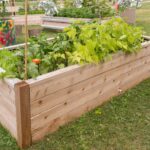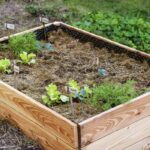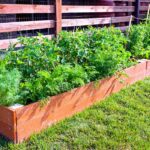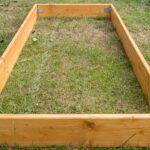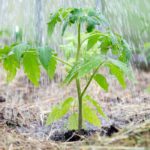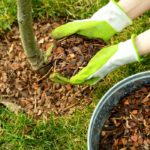Mulch offers multiple benefits to your flower bed by preventing weed growth, conserving moisture, and feeding the soil with nutrients. But with so many mulch varieties, choosing the right one for your flower bed can be tough. How can you decide which one is best?
The best mulch for your flower bed is one that offers protection for plant roots, nourishes the soil, conserves moisture, regulates soil temperature, and adds to the beauty of your landscape. Some effective organic mulch options include grass clippings, straw, and shredded leaves.
To choose the best mulch for your flower bed, you’ll decide between two broad categories: organic and inorganic. Within these categories, there are multiple mulch types suited for different applications. Let’s discover the best and worst mulch for your flower bed as well as some tips to apply mulch properly.
Does Mulch Benefit Flower Beds?
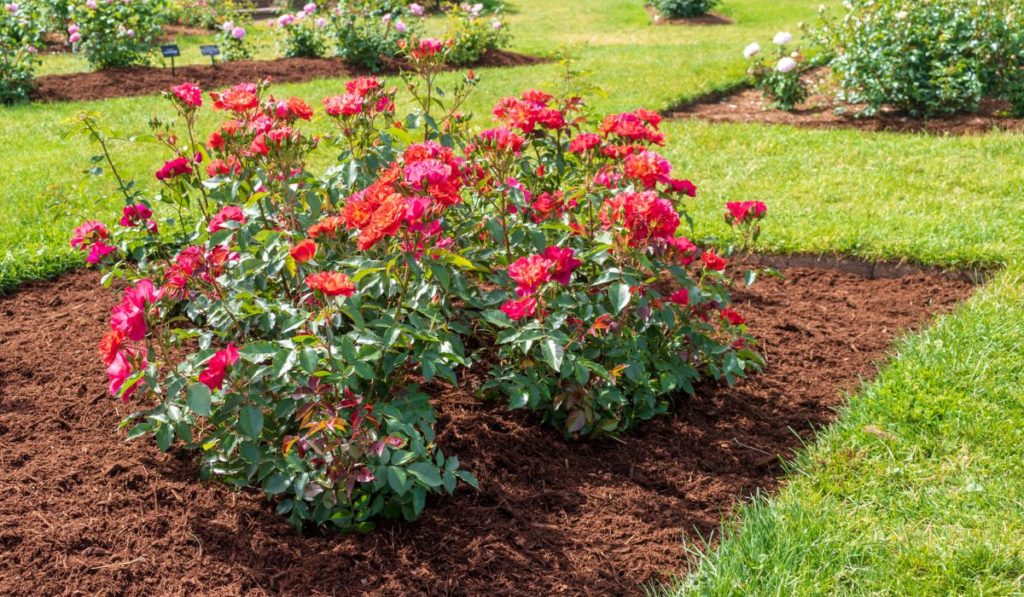
Mulch is beneficial to your flower beds in multiple ways. Whether you’re working with a new flower bed or you want to replant your existing garden, mulch makes the difference between stunted and healthy plants. Organic and inorganic mulch help your flower beds in the following ways:
- Improving soil fertility: Organic mulch decays and releases nutrients into your flower bed. Plants and microorganisms in the soil feed on these nutrients.
- Preventing weed growth: Mulch suppresses weed growth by preventing weed seed germination. Weeds can’t grow without light, and any seeds that germinate struggle to penetrate the ground covering above the soil.
- Insulating the soil against extreme heat: When it’s hot in summer, the mulch layer keeps the soil beneath cool and protects flower roots. In extremely cold weather, mulch keeps soil heat and protects the plant roots from rapid freezing and thawing.
- Hydrating the flower bed: Mulch keeps the moisture in the soil and keeps the plants hydrated. By locking in moisture, mulch promotes healthy plant growth.
- Preventing soil crusting: Mulch also prevents soil crusting on the surface and keeps the soil soft for aeration and hydration.
- Beautifying your flower bed: High-quality mulch improves the look of your flower bed and adds a distinct character to your flower bed. The mulch layer distinguishes certain areas from the rest of your landscape. Colored mulch gives your landscape a unique look that’s hard to miss.
- Protecting the flower bed: In winter, mulch offers a protective barrier for tender plants that would otherwise suffer in the snow. The protective ground layer also prevents soil erosion, which would deprive the garden of essential nutrients.
Some organic mulch types such as pinewood, cypress, or cedar chips are natural pest repellants and keep away fleas and ticks.
Different Types of Mulch
There are countless mulch types to choose from for your flower bed. Some are commercial products designed for specific applications while others are naturally available. Mulch falls into two categories, as follows:
Organic Mulch
This type of mulch is made up of plant or animal matter. Organic mulch decomposes over time and boosts the fertility of the soil. These mulch materials protect your flowers and infuse the soil with nutrients for healthier plants. As the organic mulch breaks down, the mixture changes soil texture and structure.
Some organic mulch options include:
Tree Leaves
Leaf mulch is mother nature’s gift to your flower bed. The mulch layer replicates the function of leaves in the natural habitat including suppression of weeds, maintaining soil moisture, and adding valuable soil nutrients.
Shredded leaves break down easily and add a unique natural character to your flower bed.
Shredded Bark
Tree bark is a popular mulching option because of its protective and restorative functions. The bark material comes from manufacturing facilities and is available commercially.
Shredded bark (on Amazon) doesn’t wash away easily and takes more time to break down. You won’t have to replace the mulch frequently.
Wood Chips
Ground-up wood is an affordable and readily available mulching option. The organic mulch offers a protective layer for your flower bed, preserves moisture, prevents soil erosion, and breaks down gradually.
You have a wide range of wood types and colors to choose from for your garden. Some wood chip varieties such as pine cedar and cypress also repel some pests.
Grass Clippings
Fresh or dried grass clippings are a great sustainable mulching option because the material cools the soil and breaks down easily into valuable nutrients such as potassium, phosphorus, and nitrogen. Grass clippings add porosity to your flower bed and reduce evaporation.
Straw
Straw mulch (on Amazon) is an inexpensive mulch option made from dry hollow stalks from crops such as wheat or barley. The mulch type offers a protective layer over a flower bed and breaks down slowly. Straw is not a great mulching option for a flower bed, however, because of its appearance.
Pine Needles
Fallen pine needles make a great mulch that protects your flowers and retains soil moisture. The mulch type packaged as straw lasts for years and gives your flower bed a natural look. Pine needles lock together and form a strong mulch layer that won’t wash away easily.
Recycled Paper
Cardboard or shredded newspaper is an effective alternative to traditional mulches. This heavy-duty mulch protects your plants and suppresses weeds. The bio-degradable materials are also affordable and a great way to reduce landfill waste.
Inorganic Mulch
Inorganic mulch comprises materials that won’t break down easily but it offers the best protective cover for your garden. This alternative to organic mulch offers multiple benefits for your garden, including weed suppression, soil insulation, and adding curb appeal. Common inorganic mulch types include:
Rock Mulch
Different rock varieties offer a more versatile mulching for your flower bed. You can choose from gravel, pebbles, or river rocks to give your garden a beautiful finish while also protecting the soil beneath. Rock mulch doesn’t wash away easily and offers good protection against the elements.
Recycled Rubber Mulch
Rubber mulch (on Amazon) is an eco-friendly option made from shredded tires. The material doesn’t decompose and helps with moisture retention, protecting against wind erosion, and regulating soil temperatures. Commercial rubber mulch is available in different colors, some imitating organic mulch.
However, recycled rubber mulch might release dyes and chemicals that could harm your flowers.
The Best Mulch for Your Garden
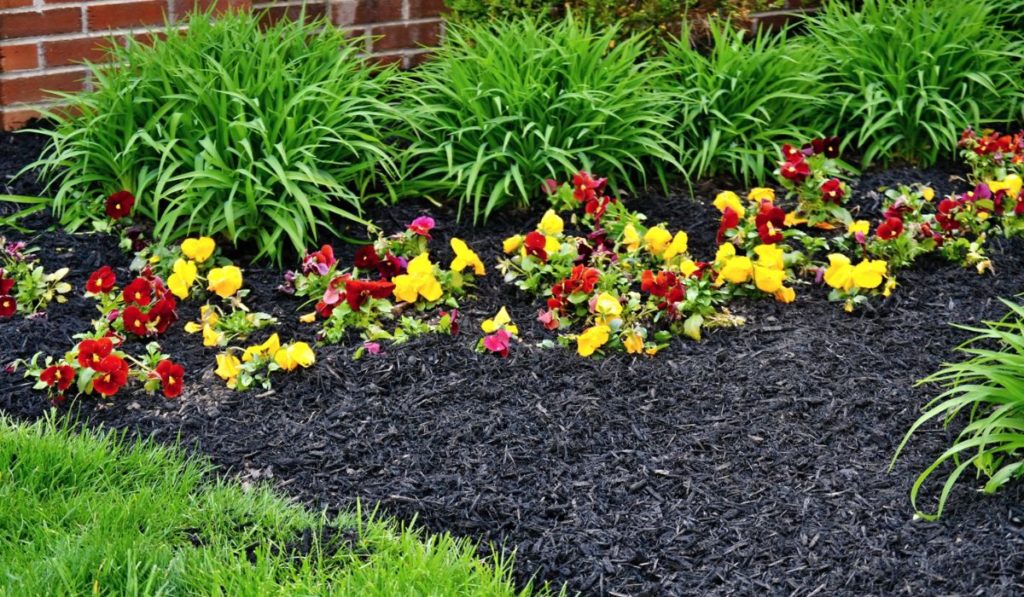
The best mulch for your garden is the one that decays easily to replenish the soil with nutrients and doesn’t require too much care. For your garden, go for organic/ natural mulch that won’t release any chemicals to harm your plants.
When choosing mulch, consider the climatic conditions in your area. Avoid materials such as rocks that might retain too much heat as this could kill your plants.
Some good organic mulch options include grass clippings, straw, and shredded leaves. While shredded bark, pine needles, or wood chips are popular choices, don’t use them directly on plants because they can change the acidity of the soil.
Organic mulches are a great choice because of the aesthetic touch they offer to your landscape. These mulching materials blend easily into the environment while giving a nice finish to the garden. The mulch layer won’t look out of place but still distinguishes your garden from the rest of the yard.
Worst Mulch for Your Garden
The worst mulch for your garden is one that won’t preserve moisture or offer enough protection for plant roots. These kinds of mulch might hinder the easy flow of moisture into the soil and ultimately affect the health of your plants.
If a mulch variety doesn’t break up easily, your garden won’t enjoy the extra nutrients. If you have to use inorganic mulch, consider the downsides such as chemicals released by dyes, heat conduction, and over-compaction caused by excessive weight.
Tips for Applying Mulch
Mulching is necessary to maintain a healthy garden, but it’s not the easiest task to complete. To promote your garden’s health, here are tips for applying mulch:
- Choose the right mulch for your garden. The amount of mulch depends on the size of your flower bed. Calculate the size of your yard and the depth of mulch to determine how much mulch you need.
- Choose the right season. Spring mulching is ideal because flowers don’t have too much growth. You can mulch any other time to protect your flower bed.
- Get the necessary tools. You’ll need some good gardening gloves (on Amazon), a pitchfork or scoop shovel to load mulch onto a wheelbarrow, and a garden rake to spread the mulch.
- Prepare your flower beds by removing weeds and any other inorganic materials.
- Lay the mulch from your wheelbarrow and rake it to create an even layer. Apply 2-4 inches of mulch for effective weed control and to conserve moisture.
- For weed control, apply a weed barrier such as newspaper or cardboards.
- Maintain your mulch by watering regularly and refreshing the materials twice a year.

